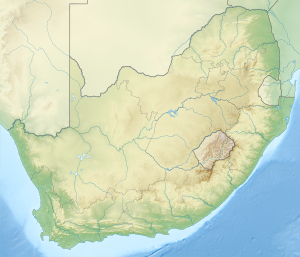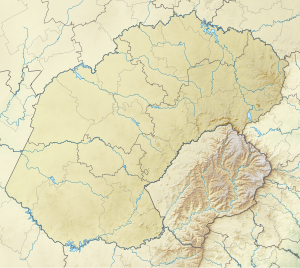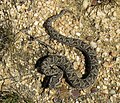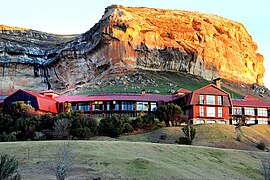Golden Gate Highlands National Park
| Golden Gate Highlands National Park | |
|---|---|
 Brandwag Buttress | |
 Location of the park | |
| Location | Free State, South Africa |
| Nearest city | Bethlehem |
| Coordinates | 28°30′22″S 28°37′0″E / 28.50611°S 28.61667°E |
| Area | 340 km2 (130 sq mi) |
| Established | 1963 |
| Governing body | South African National Parks |
| www | |
Golden Gate Highlands National Park is located in Free State, South Africa, near the Lesotho border. It covers an area of 340 km2 (130 sq mi).[1] The park's most notable features are its golden, ochre, and orange-hued, deeply eroded sandstone cliffs and outcrops,[2] especially the Brandwag rock.[3] Another feature of the area is the numerous caves and shelters displaying San rock paintings.[4] Wildlife featured at the park includes mongooses, eland, zebras, and over 100 bird species. It is the Free State's only national park and is more famous for the beauty of its landscape than for its wildlife.[5] Numerous palaeontology finds have been made in the park, including dinosaur eggs and skeletons.
Geography and climate
[edit]"Golden Gate" refers to the sandstone cliffs found on either side of the valley at the Golden Gate dam. In 1875, a farmer called J.N.R. van Reenen and his wife stopped here as they travelled to their new farm in Vuurland. He named the location "Golden Gate" when he saw the last rays of the setting sun fall on the cliffs.[6]
In 1963, 47.92 km2 (11,840 acres) was proclaimed as a national park, specifically to preserve the scenic beauty of the area. In 1981, the park was enlarged to 62.41 km2 (15,420 acres), and in 1988, it was enlarged to 116.33 km2 (28,750 acres).[6] In 2004, the park was announced to be joining with the neighbouring QwaQwa National Park.[7] The amalgamation of QwaQwa National Park was completed in 2007, increasing the park's area to 340 km2 (84,000 acres).[1][8]
The park is 320 km (200 mi) from Johannesburg and is close to the villages of Clarens and Kestell, in the upper regions of the Little Caledon River.[4] The park is situated in the Rooiberge of the eastern Free State, in the foothills of the Maluti Mountains. The Caledon River forms the southern boundary of the park, as well as the border between the Free State and Lesotho. The elevation ranges from a 1,800 m (5,900 ft) plateau in the north to heights of 2,700 m (8,900 ft) in the south.[9] The highest peak in the park (and also in the Free State) is Ribbokkop at 2,829 m (9,281 ft) above sea level.[6]
The park is located in the eastern highveld region of South Africa and experiences a dry, sunny climate from June to August. It has showers, hail, and thunderstorms between October and April. It has thick snowfalls in the winter.[10] The park has a relatively high rainfall of 800 mm (31 in) per year.[6]
Vegetation
[edit]The park is an area of rich highveld and montane grassland flora.[4] It has more than 60 grass species and a large variety of bulbs and herbs. Each of these species has its own flowering time, meaning that veld flowers can be seen throughout the summer. The park also has Afromontane forests and high-altitude Austro-Afro alpine grassland, which is scarce in South Africa. The ouhout (Leucosidea sericea), an evergreen species, is the most common tree in the park. Ouhout is a favourite habitat of beetles and 117 species occur on these trees in the park. The Lombardi poplars and weeping willows in the park are introduced species, but are kept because of their cultural and historic connection with the eastern Free State. Other exotic species in the park, for example wattle and bluegum, are systematically eradicated.[6]

Wildlife
[edit]Instead of reintroducing one of the "big five" into the park, the sungazer lizard and water mongoose were reintroduced. Twelve species of mice, 10 species of carnivores, and 10 antelope species have been recorded in the park.[11] The grey rhebok and the mountain reedbuck were present when the park was established.
Mammals
[edit]-
Male springbok
Birds
[edit]Over 210 bird species have been observed in the park,[13] including the rare bearded vulture and the endangered Cape vulture and bald ibis.
Snakes and fishes
[edit]Seven snake species, including the puff adder, mountain adder, and rinkhals, are found in the park.[6]
Geology and palaeontology
[edit]The geology of the park provides very visual "textbook" examples of Southern Africa's geological history. The sandstone formations in the park form the upper part of the Karoo Supergroup. These formations were deposited during a period of aeolian deposition towards the end of the Triassic Period.[4] At the time of deposition, the climate of the area the park covers was becoming progressively drier until arid desert conditions set in, resulting in a land of dunes and sandy desert, with occasional scattered oases. The deposition of the sandstones ended when lava flowed out over the desert 190 million years ago.[6]
The following sequence of geological formations is visible in the park (starting from the bottom): the Molteno Formation, Elliott Formation, Clarens Formation, and Drakensberg Formation. The yellow-brown Golden Gate and Brandwag cliffs are made up of the Clarens formation. The layers in this formation are 140 to 160 m (460 to 520 ft) thick. The Drakensberg Formation comprises the basaltic lava that flowed over the desert. It forms the mountain summits in the park. On Ribbokkop, it is 600 m (2,000 ft) thick.[6] The Elliot Formation is a red mudstone where many dinosaur fossils have been found.
The oldest dinosaur embryos ever discovered were found in the park in 1978.[14] The eggs were from the Triassic Period (220 to 195 million years ago) and had fossilised foetal skeletons of Massospondylus, a prosauropod dinosaur. More examples of these eggs have since been found in the park. Other fossils found in the park include those of advanced cynodontia (canine toothed animals), small thecodontia (animals with teeth set firmly in the jaw), and bird-like and crocodile-like dinosaurs.[6]
Accommodation
[edit]Accommodation in the park is available at Glen Reenen and Brandwag Rest camps. Caravan and campsites with all amenities are available at Glen Reenen camp. The hotel was formerly part of the Brandwag camp, but since its recent refurbishment, it is managed separately by SANParks as Golden Gate Hotel. The nearest town to Golden Gate Highlands National Park is Clarens (17 km to the west), but Phuthaditjhaba is also easily reached by a good tar road, driving through the access gate to the east of the park.
-
Golden Gate Hotel
-
Basotho Cultural Village landscape
-
Basotho Cultural Village hut
Notes
[edit]This park will be included in the Maloti-Drakensberg Transfrontier Conservation Area, Peace Park.
See also
[edit]- QwaQwa National Park (incorporated into Golden Gate Park as the QwaQwa homeland no longer exists).
References
[edit]- ^ Jump up to: a b Jacana Media (2007). Exploring our Provinces: Free State. Jacana Media. ISBN 1-77009-273-0.
- ^ Merriam-Webster (1 January 1998). Merriam-Webster's Geographical Dictionary. Merriam-Webster. ISBN 0-87779-546-0.
- ^ South African National Parks. "Golden Gate Highlands National Park". Retrieved 13 August 2006.
- ^ Jump up to: a b c d Geological Heritage Tours (13 August 2006). "Golden Gate Highlands National Park". Archived from the original on 27 September 2007. Retrieved 23 June 2009.
- ^ Savannah-Africa. "Free State". Archived from the original on 30 September 2007. Retrieved 23 June 2009.
- ^ Jump up to: a b c d e f g h i Footprint. "Rhebok Hiking Trail" (PDF). Archived from the original (PDF) on 28 September 2007. Retrieved 13 August 2006.
- ^ South African Government Information. "QwaQwa National Park Incorporated With The Golden Gate Highlands National Park". Archived from the original on 30 September 2007. Retrieved 13 August 2006.
- ^ South African National Parks. "Annual Report 2006/07" (PDF). Retrieved 22 October 2007.
- ^ Masai Mara Migration. "Park Entry Fees Golden Gate Highlands National Park". Retrieved 9 December 2022.
- ^ Lonely Planet Publications (1 November 2004). Lonely Planet South Africa, Lesotho and Swaziland. ISBN 1-74104-162-7.
- ^ List of Mammals present in Golden Gate
- ^ "South African National Parks - SANParks - Official Website - Accommodation, Activities, Prices, Reservations". www.sanparks.org. Retrieved 6 January 2022.
- ^ [1] Archived 26 February 2014 at the Wayback Machine, downloaded 17 July 2012.
- ^ Knight, Will (28 July 2005). "Early dinosaurs crawled before they ran". New Scientist. Retrieved 23 June 2009.
External links
[edit]- South Africa National Parks Official site.











![Chacma baboon[12]](http://up.wiki.x.io/wikipedia/commons/thumb/2/2c/Chacma_baboon_%28Papio_ursinus_griseipes%29_male_head.jpg/120px-Chacma_baboon_%28Papio_ursinus_griseipes%29_male_head.jpg)
















